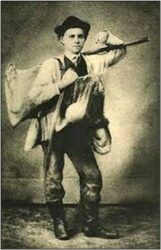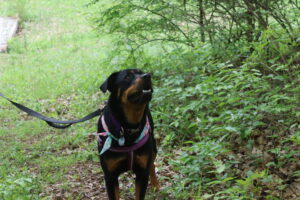By Hannah Hunt
 Bernheim Arboretum and Research Forest is a living legacy of philanthropist and visionary, Isaac Wolfe Bernheim, who immigrated to the United States from Germany in March, 1867 at the age of eighteen with only $4 in his pocket. After struggling for several years to make a living as a peddler on the east coast, he moved to Kentucky and went into the distilling business, where he achieved great success with his Bernheim Brothers Distilling Company and his popular brand of bourbon, I. W. Harper.
Bernheim Arboretum and Research Forest is a living legacy of philanthropist and visionary, Isaac Wolfe Bernheim, who immigrated to the United States from Germany in March, 1867 at the age of eighteen with only $4 in his pocket. After struggling for several years to make a living as a peddler on the east coast, he moved to Kentucky and went into the distilling business, where he achieved great success with his Bernheim Brothers Distilling Company and his popular brand of bourbon, I. W. Harper.
In 1929, Mr. Bernheim bought and endowed the land that would become Bernheim Forest, now over 16,000 acres. He dedicated this land as a gift to the people of his new homeland. Due to the land’s previous use by the sale and iron ore industries, the landscape at the time of his purchase was heavily abused and nearly devoid of trees. After 20 years of work, Bernheim opened to the public in 1950.
 Planting of the Ginkgo, Beech, and Nut Collections occurred from 1954 to 1955, and the Sun and Shade trail was established in 1960. In 1976 Bernheim added approximately two hundred specimens to its Holly Collection, becoming one of the largest displays of American hollies in North America. The Big Prairie was established in 1990, and in 1996 Bernheim was chosen as one of the three sites in the U.S. by the American Chestnut Society to plant and test new blight resistant trees.
Planting of the Ginkgo, Beech, and Nut Collections occurred from 1954 to 1955, and the Sun and Shade trail was established in 1960. In 1976 Bernheim added approximately two hundred specimens to its Holly Collection, becoming one of the largest displays of American hollies in North America. The Big Prairie was established in 1990, and in 1996 Bernheim was chosen as one of the three sites in the U.S. by the American Chestnut Society to plant and test new blight resistant trees.
In 2018, Bernheim Arboretum achieved Level IV status from ArbNet, the highest accreditation possible, placing Bernheim on an international stage alongside arboretums such as Longwood Gardens, Morton Arboretum, and Royal Botanic Gardens in Sydney, Australia. Bernheim Arboretum serves as a living tree museum, preserving precious genetic information and promoting biodiversity.
As a testament to Isaac W. Bernheim’s vision and perseverance, Bernheim today is home to a nationally-renowned 600-acre arboretum with over 8,000 varieties of documented trees, shrubs and herbaceous perennials in the arboretum, including the celebrated Hubbuch Holly Collection with over 300 specimens. Over 400,000 visitors from the U.S. and abroad now visit Bernheim each year.
Here are some general guidelines to enhance your adventure and ensure preservation of all plant collections within Bernheim Arboretum:
 Why We Don’t Climb Trees in the Arboretum
Why We Don’t Climb Trees in the Arboretum
While some of the big, twisting trees in the arboretum might be very appealing for adults and kids alike to try to climb, please keep your feet on the ground within the Arboretum. These trees are being carefully maintained by our team of Horticulturists and their status is being monitored for our plant records. Climbing on limbs may result in damaged bark or broken tree (or human) limbs. Many of our Collections were planted in the 50’s and 60’s and are aged, and should be treated delicately to help preserve them for the future. If you’re really itching to climb trees, it’s not only allowed, but encouraged at Playcosystem, our new play area located across the street from the Visitor Center.
- Why We Don’t Carve Into Bark
Although it may be tempting to carve your initials or proclamations of love into the bark of the trees in the Arboretum, we ask that you please refrain. These trees are being carefully maintained by our team of Horticulturists and their health is being monitored for our plant records. Cutting into the bark can destroy the cambium layer underneath, which is what the tree relies on to transport water and nutrients up the trunk and out to its limbs.
- Why Visitors Shouldn’t Collect
Certain times of year, you may notice fruits or nuts emerging on the trees in the Arboretum. We like to leave all of them for the critters of Bernheim. Additionally, some fruits or nuts, even if they are edible, may require special preparation before eating, and for that reason we ask you to never consume anything from the arboretum. Lastly, collection of plant material for propagation or any other purpose is strictly prohibited. If you are interested in collecting plant genetic resources for an institution, please reach out to Renee Frith, Director of Horticulture and Sustainable Landscapes.
 Where Should I Deposit Dog Waste?
Where Should I Deposit Dog Waste?
There are trash cans located at each facility at Bernheim, as well as some near popular trail heads. The Garden Pavilion and Visitors Center also supply doggy bags to make sure that your furry friend is cleaned up after. Please do not place these bags in flower beds or tree rings. These areas are maintained by our Horticulturists and Volunteers and they will not see it until it is too late! Please be courteous and place animal waste in the correct receptacles.
- Why Approaching Work Areas Can Be Dangerous
Bernheim is a working Arboretum. You may see staff operating large dump trucks, tractors, chainsaws, skid steers, string trimmers, or wood chippers. Often times the equipment is very loud and there are fast-moving parts. For your safety and ours, please refrain from approaching staff while they are operating heavy equipment. Chainsaw work and wood chipping occur frequently in the Arboretum and it is not safe for anyone to be in the immediate vicinity without a safety helmet. If you come across a Do Not Enter sign or blocked path, this is for good reason–your safety. We understand that everyone is curious about projects at Bernheim and staff enjoy that enthusiasm. Help us help you to stay safe– if you notice an area of the Arboretum that has been fenced or coned off, please do not enter the area in a vehicle, bicycle, on foot, or otherwise. Viewing from a safe distance protects us all!
- Why is Taking Shortcuts Through the Woods Harmful?
While visitors are invited to explore all areas of the Arboretum, repeated foot traffic on shortcut paths through the woods can cause compaction of the soil over time and trampling may damage the sensitive native plants that we are trying to conserve. These natural areas within the Arboretum are intended for both wildlife habitat and native plant restoration. Also, the natural wooded areas often contain poison ivy, which can cause serious skin reactions. For those reasons, we ask that you only walk either on the designated trails or in the grass when navigating the Arboretum so these areas may remain undisturbed.
- Explore the Arboretum to Enjoy its Full Beauty
While some Arboretums may ask you to keep off the grass, Bernheim is not one of them. We encourage you to get off the beaten path and explore all areas of the arboretum. Wander through the Magnolia Collection in the spring to compare the blooms of different cultivars. Weave through the American Holly Collection, once America’s largest collection of Ilex opaca, and observe the many different leaf shapes and berry colors. Picnic next to to the Olmsted Ponds. Go fishing in Lake Nevin. Make the most of your visit by exploring all that Bernheim Arboretum has to offer.
 How to Interpret Signage and Accession Tags
How to Interpret Signage and Accession Tags
Our Collections are cared for and monitored by Bernheim Horticulturists. Each tree has its own unique identity, or accession number, that allows us to maintain plant records detailing every aspect of the tree’s life—which nursery it was grown in, when it arrived at Bernheim, when it was planted in the Arboretum, and its overall health throughout the years. Visitors can learn more about the trees in the Arboretum by reading the plant signage, usually found directly in front of the tree, or by locating the accession tag that usually hangs on a lower branch of the tree. The signage will tell you both the botanical and common name, as well as the Family and native range of each specimen. The accession tag will tell you the year the tree was planted, the order in which it was accessioned, and the plant’s number in the series. To learn even more about our plants, be sure to search our records in our new plant database, IrisBG.
Following these guidelines will help you explore Bernheim while maintaining its beauty for generations to come!

